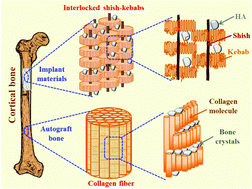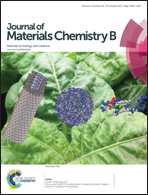Injection-molded hydroxyapatite/polyethylene bone-analogue biocomposites via structure manipulation†
Abstract
Due to insufficient mechanical performance, such as low tensile strength, the application of hydroxyapatite (HA)/high-density polyethylene (HDPE) biocomposites has been limited to use as minor load-bearing bone substitutes. In the current work, we propose to impose an intense shear flow during injection molding to tune the microstructure of the HA/HDPE biocomposites, by which an anisotropic biomimetic structure and superior mechanical properties were gained. Morphological observations manifested that the imposed intense shear induced a large amount of oriented self-reinforced superstructure, i.e., interlocked shish-kebabs, which brought not only structure similarity with the natural bone but also considerable mechanical reinforcement. For the 20 wt% HA/HDPE biocomposite, the tensile strength and bending strength of the structured sample rose from 22.4 and 20.2 MPa for the normal sample to 60.4 and 44.0 MPa, increasing by 169% and 118%, respectively, which already reaches the bounds of human cortical bone. The Young's modulus increased to 1462.0 MPa, with an augment of 37%. The impact toughness of the structured biocomposite (64.6 kJ m−2) showed as over 5 times larger than the normal biocomposite (10.1 kJ m−2). Besides, the dispersion of the HA in the biocomposites especially at the high filler content was enhanced, playing a positive role in sustaining the bioactivity. All these results indicate that the structured HA/HDPE biocomposites hold great promise for use in high load-bearing orthopedic applications.


 Please wait while we load your content...
Please wait while we load your content...